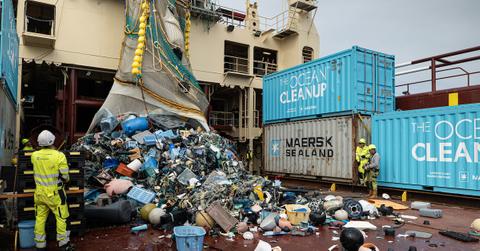The Ocean Cleanup On Alleged "Staged" Plastic Removal Efforts (Exclusive)
Updated Feb. 18 2022, 1:14 p.m. ET

We love an organization that does a good deed for the planet — as long as it actually happened, of course. Nonprofit organization, The Ocean Cleanup, alleged they collected about 8,400 pounds of plastic from the Great Pacific Garbage Patch, but experts have questioned the organization, claiming the photos from the supposed event looked staged. That said, The Ocean Cleanup controversy is creating serious drama in the realm of oceanic conservation right now.
University of Washington Associate Professor, Trevor Branch, expressed his opinion on the matter via Newsweek.
He told Newsweek: "The plastic they picked up, most of which they say is 10 to 30 years old, is so clean and free of the organisms that usually grow very quickly on anything in the ocean ... although I am not an expert in biofouling, others had similar questions."
Arizona State University marine conservation biologist, David Shiffman, expressed suspicion via Newsweek as well.
"The imagery they showed is just not at all what it would look like if one were to truly drag a big net through the ocean and scoop up plastic that had been floating there for years," he said. "It's too brightly colored, nothing is growing on it, and they didn't catch anything but plastic."
Check out the original post from the organization documenting the cleanup, below.
We spoke with The Ocean Cleanup about its latest controversy.
Using nets that can reportedly avoid bycatch, The Ocean Cleanup is working to remove 90 percent of the Great Pacific Ocean Patch's plastic by 2040. But after supposedly removing over 8,000 of pounds of plastic on Feb. 5, The Ocean Cleanup was accused of staging its efforts.
UPDATE:
Several experts claim the plastic looks too clean and free of algae and other organisms, or biofouling, to have been in the ocean for 10 to 30 years. But we reached out via email, and a spokesperson gave us an explanation.
One reason is because the patch is oligotrophic, or low in nutrients, resulting in less algae growth.
"There’s a reason these subtropical gyres – where we are currently busy catching plastic – are also called the 'deserts of the sea.' Nutrients typically come from rivers or from the upwelling of deeper waters," they tell us. "However, these gyres are far away from land and dominated by downwelling of water, not upwelling. This means that very few nutrients reach these gyres."
They also attribute the lack of biofouling to the fact that much of the plastic is floating above water.
"So-called ‘biofouling’ typically only occurs on those parts of objects that are submerged underwater," they explain. "However, if the plastic sticks out of the water, UV radiation will stop any biofouling. Good examples of this are buoys or floats: underwater, they are typically covered in barnacles, while on top, they are generally deprived of marine life."
And finally, they explain, many of the plastics have additives that preserve their coloring.
"[The additives] protect them from UV light (thus ‘preserving’ their colors) and biofouling organisms (especially for objects used by fisheries)," they tell us.
Other organizations are also working to clean up the Great Pacific Garbage Patch.
While it seems The Ocean Cleanup's efforts weren't staged, there are many other organizations that have very similar missions. In 2020, we covered the incredible cleanup efforts led by Ocean Voyages Institute, which removed 103 tons of plastic from the notoriously polluted area.
Likewise, Ocean Crusaders is constantly monitoring ocean pollution levels, and hosting cleanup efforts, to protect both marine mammals, fish, and birds alike.
In the end, it isn't about The Ocean Cleanup's drama — what matters is the organizations that are actually doing work to make our oceans a little cleaner.
Green Matters’ new book, Green Living, is the perfect guide to living an eco-friendly lifestyle for people at every stage of the process. You can order Green Living here.